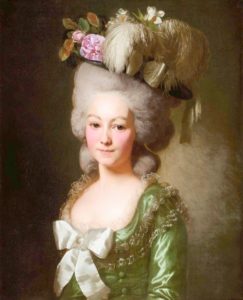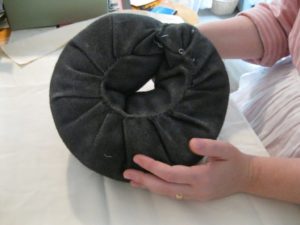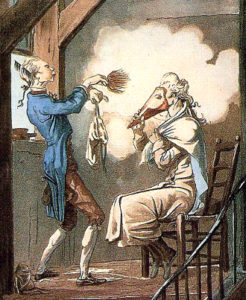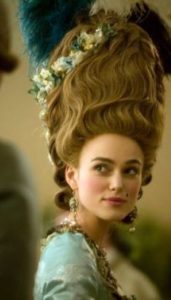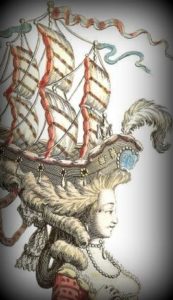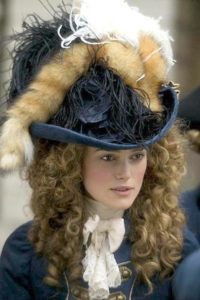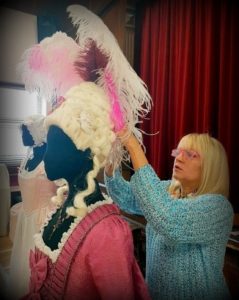The second half of the 18th century is an era particularly identified with hair and makeup these became such potent symbols of aristocracy during the Enlightenment and French Revolution.
France was one of the fashion leaders of this era. So I thought you may find it interesting to find out a little more about the face paints and hairstyles during the 18th Century. Included in my Marie Antoinette talk is a reproduction of one of the high wigs of the period as well as the lower wider wig known as the hedgehog!
Hair styling and cosmetics application had a particularly important function in France. The toilette, or dressing, was a daily ceremony in which important persons were dressed (including hair styled and cosmetics applied) before a select audience, the ritual was created by Louis 14th.
For the 18th Century ideal of beauty her forehead was high, her cheeks plump and rosy, and her skin was white. Fashionable eye colours included black, chestnut, or blue; eyebrows were divided (i.e. no monobrows), slightly full, semi-circular, and tapered at the ends in a half moon shape. Her lips were small, with a slightly larger bottom lip creating a rosebud effect, soft, and red.
The ideal woman of the 18th century had hair that was black, brown, or blond (particularly fashionable during Marie-Antoinette’s reign); strong red hair was unfashionable and generally would be dyed a different colour, although chestnut and strawberry blond were popular. Her hair was of wavy or curly texture.
Wigs were introduced in the 17th century, when King Louis 13th (1610-43), who had let his own hair grow long, began to bald prematurely at the age of 23. They were made in general with human hair, but also with hair from horses or goats to make new headdresses every day of the week.
It is in the 1760s that hairstyles featuring height began to appear. This height was generally equal to about 1/4 to 1/2 the length of the face, and is usually styled in an egg shape.
In the mid- to late-1770s, huge hair became all the rage. The height of these styles was generally about 1 to 1 1/2 times the length of the face, and was styled in what was considered a pyramid shape (it also looks very much like a hot air balloon).
Hair was nearly always curled, waved, or frizzed before styling, to create texture. Styling was accomplished with combs and curling irons, held with pins, and dressed with pomade. When height was desired, it was raised over pads made of fabric or cork shaped like a heart or spear – wool, tow, hemp, cut hair, or even wire were also used.
They were attached to the top of the head, and then natural and false hair was curled, waved, or frizzed and piled over and around the cushion. Such elaborate hairstyles could be worn for days or weeks at a time.
Side curls angled up towards the top back of the hair. The back hair was generally styled in a looped-up ponytail or braid. Long curls were often left hanging at the nape of the neck. French styles often had an extra “bump” in the front of the hair, right above the forehead. In this period, both French and Englishwomen usually powdered their hair.
Powdering was introduced when King Henry 4 of France (1589-1610) used dark powder on his greying hair. By 1715, wigs started to be powdered. Hair powder was originally used mostly as a degreaser.
White haired wigs were popular because they were expensive and rare, and so men and women began (in the early 18th century) to use white powder to colour their wigs and hair, as it was less destructive than dye.
Hair powder was made from a variety of materials, from the poorest quality in corn and wheat flour, to the best quality in finely milled and sieved starch. It was usually white, but it could also be brown, grey, orange, pink, red, blue, or violet.
The application of white powder over dark hair produces shades of light to dark grey and White powder applied over very light hair produces a heightened blond effect.
Powder was applied with a bellows (the person being powdered being covered with a cone-shape face mask and fabric smock), with a puff for touch-ups and a knife for removal. To powder wigs, people used special dressing gowns, and covered their faces with a cone of thick paper.
The high hairstyle ornaments included lots of ribbons, pearls, jewels, flowers, feathers, as well as ships, birdcages, and other items that evoked the theme. In 1774, the Duchess of Devonshire created a sensation when she introduced ostrich feathers into her hair. The high hairstyle ornaments included lots of ribbons, pearls, jewels, flowers, feathers, as well as ships, birdcages, and other items that evoked the theme. In 1774, the Duchess of Devonshire created a sensation when she introduced ostrich feathers into her hair.
Fashion loving ladies of XVIII century were often decorating their hair with jewels. The most sophisticated beauties tried to come up with a more original decoration by attaching stuffed birds, figurines, frigates, ships with sails, mini-gardens with tiny artificial trees and castles models. The making one single piece stylists worked between 1 and 10 hours in a row. Marie Antoinette even put a Frigate in her hair to celebrate a French naval victory!
Such elaborate hairstyles could be worn for days or weeks at a time The hair was not washed at all for months and was only combed with specially made tool resembling to a metal hand..
To keep this artistic work as long as possible, it was regularly greased with pork lard. A typical hairstyle was height of about one meter. Sleeping with such a haircut was possible only on special cushions. A metal grid was worn on the head to protect the sleeping beauty from mice. Because of the unusual shapes of each individual hairstyle, bespoke hats were made in order to not damage the hair.
- In 1781, Marie-Antoinette lost much of her hair after the birth of the dauphin. Famous coiffeur Léonard Autie later claimed that he created for her the coiffure à l’enfant, which she wore, along with her chemise à la Reine, in the famously reviled painting by Louise Elisabeth Vigée-Le Brun.
- Growing interest in what were considered “natural” fashion, brought about by the Enlightenment, created what was a more “natural” style in the 1780s. During 1779-81, the shape of the hair started to become rounder and height began to diminish. This lower form of the pouf tended to be worn with fatter side curls than previously.
- This became the hedgehog style was fashionable in the 1780s and 1790s. This is the very big enormous hair full of curls that seems easily done and wildly styled, you can see it all the time in Thomas Gainsborough portraits
- The hair was cut shorter to form a large curly or frizzy halo around the head, which was wider than tall. A small hank of much longer hair, either left straight, in ringlets, or braided, hung down the back or was worn looped up. These styles could still be very large, and false hair continued to be used to fill out a woman’s natural hair.
In keeping with this more “natural” look, powdering began to fall out of favour, although it still appears frequently in paintings and fashion plates. Powder fell definitively out of fashion in France with the Revolution of 1789; in England. In keeping with the mood of the period, ornamentation became more restrained, generally a ribbon, or a few feathers, flowers, or jewels.
I hope you have enjoyed reading this post and that you will come along to my Marie Antoinette talk to see both the very high over ornate court wig and the hedgehog wig yourself!

